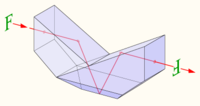
Abbe-Koenig prism
Encyclopedia

Prism (optics)
In optics, a prism is a transparent optical element with flat, polished surfaces that refract light. The exact angles between the surfaces depend on the application. The traditional geometrical shape is that of a triangular prism with a triangular base and rectangular sides, and in colloquial use...
used to invert an image (rotate it by 180°). They are commonly used in binoculars
Binoculars
Binoculars, field glasses or binocular telescopes are a pair of identical or mirror-symmetrical telescopes mounted side-by-side and aligned to point accurately in the same direction, allowing the viewer to use both eyes when viewing distant objects...
and some telescope
Telescope
A telescope is an instrument that aids in the observation of remote objects by collecting electromagnetic radiation . The first known practical telescopes were invented in the Netherlands at the beginning of the 1600s , using glass lenses...
s for this purpose. The prism is named after Ernst Abbe and Albert Koenig.
The prism is made from two glass prisms which are optically cemented together to form a symmetric, shallow Vee-shaped assembly. Light enters one face at normal incidence, is internally reflected
Total internal reflection
Total internal reflection is an optical phenomenon that happens when a ray of light strikes a medium boundary at an angle larger than a particular critical angle with respect to the normal to the surface. If the refractive index is lower on the other side of the boundary and the incident angle is...
from a 30° sloped face, and then is reflected from a "roof" (German Dach) section (consisting of two faces meeting at a 90° angle) at the bottom of the prism. The light is then reflected from the opposite 30° face and exits, again at normal incidence.
The net effect of the internal reflections is to flip the image both vertically and horizontally. This produces a 180° image rotation (without changing the image's handedness
Handedness
Handedness is a human attribute defined by unequal distribution of fine motor skills between the left and right hands. An individual who is more dexterous with the right hand is called right-handed and one who is more skilled with the left is said to be left-handed...
), and allows use of the prism as an image erecting system. Unlike the more common double Porro prism
Porro prism
In optics, a Porro prism, named for its inventor Ignazio Porro, is a type of reflection prism used in optical instruments to alter the orientation of an image....
configuration, the Abbe–Koenig prism does not displace the output beam from the input beam, making it advantageous in some instruments. The prism is also less bulky than the double Porro design.
The prism is sometimes simply called a "roof prism
Roof prism
A roof prism is in general any kind of reflective optical prism containing a section where two faces meet at a 90° angle...
", although this is ambiguous because other roof prisms exist, such as the Amici
Amici roof prism
An Amici roof prism, named for its inventor, the Italian astronomer Giovanni Amici, is a type of reflecting prism used to deviate a beam of light by 90° while simultaneously inverting the image...
and Schmidt–Pechan designs.
A variant of the Abbe–Koenig prism replaces the "roof" section of the prism with a single mirror-coated reflecting surface. This type of prism flips the image vertically, but not laterally, changing the handedness of the image to the opposite sense.

